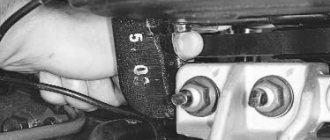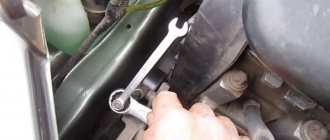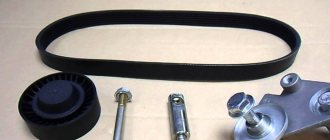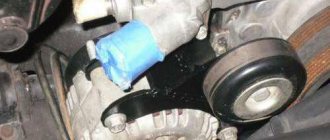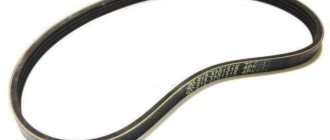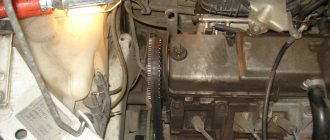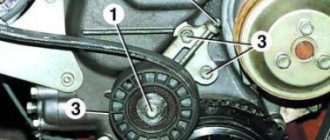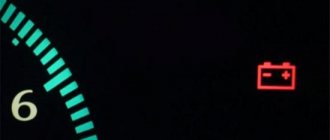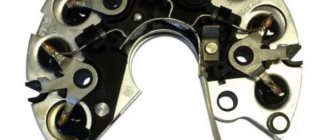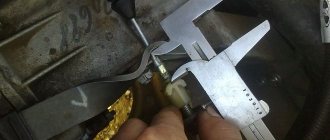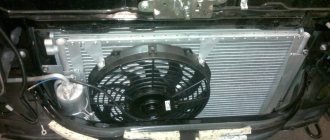The alternator belt whistles on a Priora! This problem or malfunction, so to speak, is felt by every tenth owner of this brand of AvtoVAZ’s brainchild! In today’s article I will tell you why the alternator belt whistles and how to get rid of the annoying noise.
The alternator belt is a structural element of the engine that transfers mechanical energy from the crankshaft to the generator, which, in turn, converts it into electricity. The interaction between the generator and the crankshaft is ensured by a belt connection mounted on pulleys.
The alternator belt whistles: what to do?
- Why does the alternator belt whistle?
- In the cold
- After replacement
- How to eliminate a whistling alternator belt?
Sometimes the car makes noises similar to the whistle of the “robber nightingale”. A possible source of this sound is the belt drive of the machine's generator. The article will tell you about the causes of this unpleasant phenomenon, as well as what can be done to correct the situation.
Whistling under the hood, or Woe from the belt
What can happen to the accessory drive belt and what will be the impact of its failure?
Results of the past season: father's belt with buckle was recognized as the best Teacher of the year.
Folk humor
What do belts do?
Features and possible causes of alternator belt whistling
To “cure” the problem, you must clearly understand the intricacies of the generator and the likely causes of the malfunction. Also read the article on how to check the diode bridge of a generator.
The main purpose of the generator is to power the electrical equipment of the car. But how is constant rotation of the rotor ensured?
There are special pulleys on the engine crankshaft and the generator shaft on which the belt is tensioned. After starting the engine, the crankshaft begins to rotate, driving the generator rotor.
The appearance of a squeak is due to increased friction of the belt on the generator pulley (crankshaft) or normal slipping.
In practice, the causes of squeaking and whistling may be the following:
- Increased belt wear. Sometimes even additional tension does not help.
- Contact of various liquids (antifreeze, oil, etc.) on the generator pulley (crankshaft) or directly on the belt.
- Poor quality belt.
- Bearing wear in the generator.
This malfunction most often occurs at increased loads. The bearing may whistle or rattle. In such a situation, only replacement with your own hands or at a service station can help out.
Howling and whistling in the generator
This is a generator belt for Priora
The Priora generator may be too noisy if there is a short circuit in the valve (the rectifier unit needs to be replaced), or the bearings from the generator are damaged. Noise can also be caused by an interturn short circuit or problems associated with the stator winding shorting to ground. In this case, you can hear sounds similar to howling. And this is fraught with replacing the stator. But most often, drivers begin to worry when they hear the alternator belt whistling, because this means that there is no charge, the battery is low, and the car may get stuck somewhere far from the service station.
Replacing the alternator belt is not a big problem for most representatives of the stronger sex. However, Priora has a number of features that complicate this simple operation. And this is due to the fact that the car in the basic configuration can be equipped with power steering or air conditioning, which gives a larger belt size, as well as its different location.
Such design features cause the power steering pulley to be low, so the alternator belt runs around the supports of the machine’s power unit. This means that the replacement will have to be done using a powerful jack (bottle type) or in a service station. To replace the alternator belt on a Priora car with air conditioning, you need to take keys “17” and “13” (2 pcs.), heads “17” and “10”, a lever, WD40, a key for tensioning the alternator belt on a Priora .
Let's start work. Main stages:
- wet the mounting bolts on the engine mount and bracket with WD40;
- after a quarter of an hour, unscrew the bracket nut, lift the right front wheel (with a jack), place a lining under the engine, remove the wheel;
- lower the car slightly, unscrew the tension roller, bend the alternator belt, unscrew the bolts securing the cushion;
- we release the car so that the engine begins to “hang out”, move the cushion towards the engine, remove the belt and install a new one;
- We jack up the Priora to lower the engine (we control the position of the alternator belt and airbag);
- We tighten the cushion bolts and the bracket nut, put the wheel back on, and lower the car to the ground.
How to eliminate a whistling alternator belt
You can get rid of the generator belt whistling by eliminating the reasons that cause it to slip on the pulleys.
If there are signs of belt slipping, accompanied by an unpleasant whistle, we suggest eliminating it in the following order:
- Stop the engine, open and secure the hood to prevent it from closing spontaneously;
- Carefully inspect the alternator belt without removing it from the car. There should be no tears, protruding threads or other visible damage on its surface. If they are detected, the belt must be replaced with a new one.
- Both the inner and outer sides of the belt must be dry and clean, without traces of dirt, oil and other vehicle technical fluids. The same applies to pulleys.
- Check the degree of belt tension - in most cases, the cause of a whistle from under the hood is precisely the weak tension of the generator belt. We wrote about how to properly check the tension level of the alternator belt here.
For information on the optimal degree of tension of your car's alternator belt, refer to its operating instructions.
- If necessary, adjust the belt tension. A good video instruction for adjusting the alternator belt is at the bottom of this page.
- If all of the above did not help and the alternator belt continues to squeak obnoxiously, then with the engine running and good lighting, carefully inspect the line of pulleys for alignment.
An indirect sign of pulley misalignment is the poly V-belt jumping from track to track and sliding off the pulley.
- Pay attention to the linearity of rotation of the pulleys - if any pulley rotates in a figure eight, it will tear and throw off the belt. Most often, pulleys with a rubber damper behave this way, which over time loses elasticity and ceases to perform its functions.
And so, if the generator belt has not stopped whistling, but it is intact, clean, well tensioned, and the pulleys rotate smoothly and smoothly, then you can try to correct the situation using another method:
- Remove the alternator belt and carefully inspect it again for damage and dirt. If the belt is intact, then you need to clean its surface from the inside and outside (you can use gasoline or kerosene); if damage is found, buy a new belt.
- With the generator belt removed, thoroughly clean the pulleys from dirt and dust. This is best done with a wire brush. You can also use gasoline or kerosene.
- Place a clean belt on the clean pulleys and adjust its tension. After this, the whistling of the alternator belt should disappear.
If all of the above did not help and the belt whistle has not gone away, then the problem lies either in the quality of the belt itself or in the equipment that is driven by it: tension rollers, generator, power steering pump, air conditioning compressor, etc. Perhaps the grease in the bearings has simply thickened or they have failed, or perhaps the reason is much more serious, so in this case it would be better to seek help from a car service specialist.
You can try to temporarily eliminate the whistling noise using special auto chemicals, so-called conditioner-tensioners for drive belts. This, of course, will not solve the problem, but the whistling will disappear for a while.
Preventative maintenance of the timing belt and tension pulley - all about fret repair - Website about
The article will discuss the causes of timing belt whistling and ways to eliminate this problem.
Where to look for the source of noise?
Many car owners are faced with such a problem as a sharp whistle (squealing) from under the hood when the engine is running. It can appear both when the engine is “cold” and when the engine is fully warmed up, under different loads.
Usually everyone starts to blame the occurrence of such a problem on the generator and its belt. At the same time, they do not pay attention to the second belt drive - the gas distribution mechanism.
But the appearance of a whistle in it is a more dangerous problem than in the drive belt of attachments.
Many people do not look for a problem in the timing belt for one simple reason - to ensure full transmission of force from the crankshaft, a belt with a toothed working surface is used. And the presence of teeth eliminates the possibility of slipping on the pinion and gear.
And since there is no slippage, then a squeal under the hood (one of the signs of increased friction between surfaces) cannot appear. The same cannot be said about the attachment drive belt.
To transmit force to the generator and other elements, a V-shaped or multi-ribbed belt without any teeth is used. That is, it is quite capable of slipping along the pulleys, which is why they are looking for the cause of the whistle primarily in this drive element.
- But many do not take into account that the timing belt transmits force not only to the camshaft, but also to the water pump.
- In addition, in order to prevent the teeth from jumping over the gear, the drive must be well tensioned, and for this purpose a tension roller is added to the design.
- And engines with two camshafts often use another roller - a bypass roller, also known as a parasitic roller.
- That is, it turns out that the timing drive additionally contains a number of elements, which often cause the appearance of uncharacteristic noise.
In general, if sharp third-party sounds appear when the engine is running, you should look at all drive belts. Since the generator drive whistles more often, you should pay attention to it first of all.
The main reasons for the appearance of third-party sounds in the timing drive
In general, it is not difficult to find out which drive has problems. It is enough to remove the alternator belt from the car and start the engine.
- A squeak that disappears or continues to sound will let you know where to look for the cause.
- If there is a squeal even with the belt removed, there is definitely a problem with the timing drive.
- To more accurately identify what exactly caused it without any disassembly, you can use a technical phonendoscope.
- Using it, you can identify the area where the sound occurs, which will allow you to immediately determine which of the elements is faulty after sampling.
- There are not so many main reasons for timing belt whistling:
- The belt itself can make sounds. If it is extremely worn, made of low-quality material, and not tensioned enough, then passing through the rollers (and it contacts them with a smooth surface), it will slip, making unpleasant sounds;
- The rollers may squeal due to the belt being tightened;
- Technical fluids (oil, antifreeze) have come into contact with the drive. As a result, they act as swarms of lubricant, reducing friction between the surfaces of the rollers and the belt, which causes slippage;
- Bearing wear. To ensure ease of rotation of the rollers and pump, bearings are installed in their design. If these elements are extremely worn out or there is insufficient lubrication, then increased friction occurs in them, accompanied by a squealing sound;
- Carelessness in carrying out work to replace the belt, resulting in the bending of the axis of one of the rollers. This leads to the fact that the position of the roller changes slightly, and due to a slight misalignment, the friction between the drive and the tension or bypass element increases.
POPULAR WITH READERS: How to check the starter, useful tips
Each of the reasons has its own characteristic features. For example, if you use a belt made of low-quality material that does not have sufficient elasticity, then in winter the rubber will “tan” after being parked in the cold.
- As a result of this, the drive element will be the cause of the “cold” whistle, which disappears after heating.
- As the temperature rises, the belt becomes more elastic and friction disappears.
- Approximately the same thing happens when technical fluids get in, but in this case the sound may last longer (until the oil or antifreeze rubs in).
- But wear of the bearings or bending of the roller axis is accompanied by a squealing noise in all modes of engine operation and under any temperature conditions.
Generator malfunction.
If the whistle does not stop after reducing engine speed. It is most likely that the generator shaft rotates with difficulty.
Due to mechanical damage. The rotor rotates on two support bearings. Bearings may fail. And make it difficult to rotate the rotor shaft. In this case, knocking and extraneous noise will be heard inside the generator. The generator will have to be removed and repaired. The generator shaft in the belt-free position should rotate easily. Without effort, jamming and extraneous noise.
Other reasons
The noise can also come from a broken seat and a worn shaft.
Of course, the generator can also make noise due to a short circuit.
The timing belt may hum, and the owner may think it is a generator. In this case, you need to remove the belt and listen - if the noise disappears, then it was the belt.
For many Russian drivers, the generator begins to hum after heavy rain. This means that water gets inside the unit, and until you disassemble the element and clean everything inside, nothing will help.
And of course, a relay or integral. Brushes cost pennies, so to check, it is advisable to change them first. Then listen to see if there is a hum.
Thus, the generator can hum for various reasons, but the most common are: bearing failure, a short circuit in the diode bridge, or a wire falling off.
Forget about fines from cameras! An absolutely legal new product - Traffic Police Camera Jammer, hides your license plates from the cameras that are installed in all cities. More details at the link.
- Absolutely legal (Article 12.2);
- Hides from photo and video recording;
- Suitable for all cars;
- Works through the cigarette lighter connector;
- Does not cause interference to radios and cell phones.
Why does the belt of additional units whistle when starting the engine when cold: probable reasons
How to make sure
It’s not difficult to guess what to do when the alternator belt squeaks or what to do when it whistles - you need to check the tension. Often the belt structure is weakened due to unqualified assistance or stretching during long-term use. This is the first and simple rule when such a malfunction is detected. By the way, it is only available in the case of recent installation of a new product.
However, not all machines have units connected through a generator. On many cars with a timing chain drive, there may be two belts: one connects the current-generating unit and the cooling system pump to the engine. The second is a power steering pump and an air conditioning compressor with a motor.
The test method involves applying additional load to the belts by using the maximum power of the attachment. The alternator belt may squeal at idle if all electrical appliances are activated at the same time:
- Heated seats.
- Car radio.
- Heated side mirrors and rear window.
- High beam headlights.
- Cabin heater.
Diagnosis of the presence of extraneous sounds when another belt is operating consists of activating the air conditioning system while simultaneously rotating the steering wheel. The installation scheme of belt structures may be different - it all depends on the design features of the power unit.
For your information. Inspecting the engine compartment is the best method for determining the number of straps.
Causal factors
Insufficient tension is not the only reason why the belt whistles when starting the engine cold or hot. A worn-out product can also produce extraneous sound: the rubber component becomes tanned in the cold. Insufficient elasticity does not allow the transmission of torques of the required magnitude.
Contamination of the poly-wedge part leads to loss of proper adhesion properties due to rapid wear. It is critical to evaluate the presence of oil stains on the working surface of the strap. Often a whistle is observed a few seconds after passing a puddle. In this case, there is no need to take any action - the product will dry out and the squealing will go away.
As it was before?
Previously, on cars, the belt drove only one unit - the generator, which simplified the establishment of the cause of the sound (there are only two options - the belt itself or the generator).
With the improvement of power plants, the amount of equipment that is driven by the generator belt has increased and it has already begun to be called an attachment drive.
It is now considered common practice that a flexible transmission simultaneously rotates 3-5 units, not counting the auxiliary elements - bypass and tension rollers, although there are cars in which the element is driven only by a generator, for example, a Lada Priora without air conditioning.
But on the Ford Focus 2, the belt drives the generator, power steering pump and water pump (cooling system pump).
On the Reno Logan, the amount of driven attachments depends on the configuration - in the simplest version, the belt drives only the generator, on models with power steering the element already “turns” the amplifier pump, and in cars equipped with air conditioning, the drive also turns the climate compressor -systems.
If we take the Hyundai Tucson, then in this crossover the task of the belt already includes driving the generator, power steering pumps and cooling system, as well as the air conditioning compressor.
Types of belts. Wedge and polywedge
The V-belt is still found in cars, but is gradually giving way to more efficient solutions under the hood. It can be distinguished by its characteristic trapezoidal cross-sectional shape, similar to a wedge. It was V-belts that appeared at the dawn of the automotive industry, when it was necessary to connect only one generator pulley to the crankshaft.
Sometimes the drive belt, instead of a solid wedge, has a number of transverse ribs on the inside. Such belts, called timing belts , have greater wear resistance.
Belt whine when turning on the air conditioner
This whistle is more unpleasant because the alternator belt may have nothing to do with it. Although, given the changing load on the generator, it is quite possible that the belt slips along the pulley under load. The probability is small, but it is there. In this case, you just need to tighten the belt and the whistling should stop. If the whistle remains, the problem is in the air conditioning compressor, and the whistle is most likely the air conditioning compressor clutch drive belt.
It may not always be the alternator belt that whistles when the air conditioner is turned on.
There is very little pleasant here, since the minimum that you have to do to eliminate the noise is to change the oil in the compressor (depending on the design of the air conditioner - Kia Sid, Kia Rio, Hyundai Accent, Tuscon). In some cases, the compressor drive clutch may slip - due to the lack of the required amount of freon, the compressor lacks lubrication and, naturally, it is more difficult for it to spin. This also affects the load on the electromagnetic clutch. You can also try lubricating all the compressor bearings and the bearings on the pulley, again depending on the design of the air conditioner. If all else fails, replace the compressor or electromagnetic clutch.
Reasons for whistling
The cause of the whistling may be hidden both in the belt itself and in nearby units. When a car owner asks for help, it often turns out that the generator is whistling.
Belt faults
There may be several reasons why the VAZ-2110 alternator belt whistles. However, the first place in terms of frequency of occurrence is the wear and tear of the material from which it is made. The rubber stretches, loses its shape, and begins to slip.
Diagnostics is carried out visually, based on the degree of belt tension. If it sags and can be easily turned by hand (while the pulleys remain motionless), then the cause of the malfunction can be considered found.
In addition to the above, the belt drive whistles when the pulleys are oiled. This usually happens on older engines, where oil seeps through seals and gaskets. The generator drive on Priora and other VAZ models is not geared. Therefore, it easily slides over oily surfaces. Diagnosis is carried out visually.
The drive may not whistle constantly, but periodically whistle for some time after a cold start in winter. In general, if the situation returns to normal after warming up, no intervention is required. The fact is that the rubber from which the element is made becomes hard in the cold and does not adhere tightly to the surfaces of the pulleys. As it warms up, it takes on a working form and the whistling stops.
Generator faults
The problem with the whistling of the VAZ-2107-VAZ-2101 generator and the entire front-wheel drive line of cars usually lies in a collapsed front cover bearing. In this case, both the bearing itself and the belt slipping along the jammed pulley can make noise. The malfunction is determined “by eye”.
In some cases, alternator drive slippage may be caused by a misaligned alternator pulley or crankshaft pulley. The belt begins to move at an angle, touching the side surfaces. At the same time, even a new alternator belt will whistle. A breakdown can be determined by severe wear on the belt drive. The drive “eats” on the sides.
Generator characteristics
Lada of the latest generation
The standard installation requires the presence of model 5102.3771, which is produced in Russia, which has a built-in rectifier unit and an electronic regulator for voltage during right rotation (on the drive side). The advantage of a generator of this brand is that it provides increased current output at low speeds (4-6 A when reduced to 300 rpm), which is a positive quality for traveling by car in winter. In addition, this feature of operation allows it to be equipped with an automatic transmission.
The technical characteristics of the generator 5102.3771 are as follows:
- weight - 5.41 kg;
- the gear ratio of the engine and generator on the Priora is 1 to 2.4;
- specific power - 205 W/kg;
- the maximum current output at 14 V is 80 A;
- adjustable voltage - from 13.8 to 14.4 V.
Why does the belt whistle when cold?
The problem of whistling when cold can have several varieties. A squeak or whistle does not appear when the engine starts, but after a couple of minutes. This problem is easily diagnosed, since after the engine reaches operating temperature, the sound disappears.
The reason for the non-standard behavior of the belt is also hidden in its slippage. The torque transmitted from the crankshaft is not sufficient to spin the pulley. There are several reasons for this problem:
- Inaccurate selection of bearing lubricant for the generator. Due to the compaction of the lubricating fluid consistency at low temperatures outside, the generator pulley is not able to function as usual until the machine’s power unit warms up. At engine operating temperature, the lubricant will defrost and the unpleasant sound will disappear. The solution to the problem will be for the car owner to purchase a lubricant option that is more resistant to temperature changes outside the window.
- Weak tension. This situation is identical to the previous one. Until the engine reaches the required operating temperature, due to low tension, the belt is not able to perform its functions at the required speed and will slip.
The squeaking of the alternator belt when cold can be a sign of serious problems - a jammed pulley. This problem can easily be diagnosed on your own. The car owner should try to turn the specified part by hand. If the attempt does not lead to success, then you will have to either replace the generator or repair the broken part.
Preparation at work
Before actually tightening the belt, you will need to perform a number of preparatory manipulations.
- Clean the surfaces of the nuts of the tension device of the LADA Kalina generator. A regular metal brush is suitable for this.
- Wet the indicated nuts with a penetrating agent, such as WD-40, to ensure easy loosening.
- Stock up on the necessary set of tools - wrenches, the dimensions of which are “8” and “19”.
Remember the importance of the procedure for timely tightening the belt, because with a weakened transmission, the efficiency of the generator is significantly reduced, and the on-board network suffers from power outages.
Why does the alternator belt whistle when starting a cold engine?
So, normally the poly V-belt drive operates silently. If interpreted strictly, this is true for dry weather. On rainy days, the drive belt may whistle... in some situations.
So, after driving quickly through deep puddles, the alternator belt may squeak for some time. There is nothing strange or dangerous about this, it’s just that water got on the rubber product, causing the adhesion of the rubber to the metal to be disrupted and the strap to slip. As soon as the moisture is removed and the part dries slightly, the whistle will go away on its own.
But you really should be indignant when the squeal appeared naturally:
- Recently a service was carried out, during which a rubber product was removed/changed. For example, scheduled maintenance with replacement of valve stem seals or unscheduled intervention in the timing belt.
- The belt hasn't been changed for a long time.
Replace according to service life
Rubber elements are limited in the duration of use not only by kilometers, but also by years. For example, our editor-in-chief Vasily Terkin prefers to use public transport, and uses the car only occasionally - for outings into nature on weekends and only in the summer. The total mileage is small, but the car has already passed the first ten. The owner rates its reliability as a solid “five”, since all consumables change over the years. “Motor oil - every year, coolant - after three, belts - after five years,” our chief editor briefly explains the secret of confidence in your car.
The fact is that a belt is, first of all, rubber, and over time it hardens and cracks. Stiffened wedges do not cling to the pulleys, but slip. In addition, the risk of driving with a broken strap increases significantly, and as a result, stopping with a completely dead battery.
The loss of elasticity is especially noticeable with the arrival of frost. When starting a cold engine in severe frost, the belt whistles quite a bit until it gets warmer under the hood. By the way, it makes sense to think about insulating the radiator before winter. A characteristic feature is that with the arrival of a thaw, the squeaking disappears.
Pull
This is the first thing to do when the belt squeals after a recent replacement or removal. "Not always!" - says Alexander M., sketching out three belt drive schemes that automakers use:
- Without tension device. The gear tension is not adjusted either automatically or manually. It would seem convenient - I tucked the strap onto the pulleys and forgot about it. In fact, such a scheme is unsuccessful. When slippage begins, the product cannot be tightened. It’s good if it happened in the city, but what if on a long road? Breakage will occur much faster if the rubber wedges slide on the metal. And what does the word “stop” lead to in the transmission of torque to the generator, and it’s unnecessary to say...
- With automatic tensioner. A good scheme. The rubber product is always taut, which is why there is no need to climb into the aggregate part again. Basically, change the strap on time and keep an eye on the rollers. In terms of whistling, everything is simple - either an old/low-quality new belt, or a roller mechanism with an automatic tensioner.
- With manual adjustment. This is where you need to try to tighten the eccentric roller.
The height of skill is to set the belt tension by eye or, more precisely, by your fingers. If you are new to the car industry, then you should add a gauge to your fingers to measure the deflection according to the instructions or... use the universal recipe:
- Install the strap so that it is clearly loose. Do not counter the adjusting roller.
- Start the engine.
- Turn on all electrical equipment. Start the air conditioner and, if the car has power steering, turn the steering wheel. A squeal will appear from under the hood and this is a signal to action.
- Rotate the adjusting roller until the squeal goes away. Take precautions!
- Stop the engine.
- Lock the roller part.
Step-by-step instructions for eliminating the defect
If noise appears when starting the engine after replacing an element, then there are several ways to eliminate the problem. Each of them will be considered in turn. If the quality of the strap is too low and it is already worn out, then it will need to be replaced; there are no other options. We will not consider this process, since it is individual for each car.
Use the search on our website to find step-by-step instructions for replacing an element for your car. You will find more information about this here. Next, we will look at options for eliminating the problem without removing the strap.
Lubricating the strap
Lubricating the element is one of the solutions to the problem if, after replacing the component, noise appears when starting the engine.
To lubricate the component, you need to purchase a special aerosol, which is sold in any store. In addition, universal WD-40 can be used for these purposes. Naturally, this solution is temporary, but it will only take a few minutes, after which the noise will no longer bother you.
Lubricated tension roller
- Take your aerosol and open the hood of your car.
- Remove the protective cover of the mechanism, which is secured with bolts, using the appropriate wrench.
- Be careful as you will need to start the car for it to work. This will make lubrication more effective. After starting the engine, you will need to aim to ensure that the liquid hits the inner parts of the strap, that is, the teeth. Lubricate the element for five to ten seconds so that the liquid is guaranteed to reach all the teeth.
- Stop the engine and replace the mechanism cover. Enjoy the results.
Repairing the leak
If the reason why the whistle appears is the ingress of engine oil or other liquid, then it is necessary to eliminate all possible leaks:
- If engine oil gets in, first check the cylinder head for leaks. If the head even slightly moves away from the block itself and oil comes out, then you will need to dismantle the head and grind it. You will also need to change the gasket, since in practice it is the cause of oil leakage.
- If antifreeze is leaking, then also check the contact point between the cylinder head and the block itself. It is possible that coolant enters the engine due to a broken gasket. Also check all cooling system pipes to ensure they are not leaking or leaking.
- If the problem is “brake fluid” or, for example, air conditioning fluid, then you need to identify all possible leaks. Observe the timing mechanism with the engine running. You may be able to identify the problem without removing the belt.
Belt whistles: diagnostics and search for causes
First of all, at the initial stage you should turn off the internal combustion engine, after which you should take a flashlight and very carefully inspect the generator belt for damage, delamination and other defects. It is important to note even the smallest cracks, protruding threads, etc.
- If defects are detected, the belt should definitely be changed. If visually it is in good condition, then the belt on the generator itself (provided that this element worked normally before) is not the cause of the whistle. We also note that during inspection you should pay attention to the presence of oil stains, moisture and accumulation of dirt on the belt.
- If, after adjustment, the belt continues to whistle, the engine should be started and with the internal combustion engine running, carefully inspect the line of the pulleys, as the alignment may be disrupted. For example, if a serpentine belt is jumping or slipping off a pulley, this often indicates problems with pulley alignment.
It is also important to observe how the pulleys rotate. If one of the pulleys produces a figure of eight during linear rotation, then there is a high probability of the belt jumping. By the way, if the pulley has a rubber damper, then the said rubber ages over time, loses its elasticity and the damper does not work properly.
- Let’s also consider the case when visually everything is normal, and the belt itself is normally tensioned, but squeaks. It happens that even if there is no visible dirt, the belt needs special cleaning. To do this, you need to remove it, then treat the surface from the inside and outside with gasoline or kerosene.
If no damage is detected, it is necessary to thoroughly wipe the belt from dirt and dust. This can be done with a brush with soft or medium-hard bristles. At the same time, the pulleys are also cleaned, after which the belt is put back on and tightened.
- There are also special rubber conditioners on sale that are applied directly to the belt to extend its service life, maintain elasticity, etc. It happens that after treatment with such compounds, the belt stops whistling and squeaking on a permanent basis or temporarily.
In turn, if the methods listed above do not help in any way, then the problem is not related to the belt and the cause needs to be looked for further, and already in the attachment.
You need to check everything, from the tension rollers and bearings of the generator to the power steering pump, water pump, air conditioning compressor and other equipment. In some cases, the cause is grease or wear in the bearings, while in others the power steering pump, etc. may be problematic.
Belt whistling has been eliminated — Lada Priora Hatchback, 1.6 l., 2011 on DRIVE2
An entry for those who are looking for a belt that does not whistle! (at least for me) I, like some of the prior drivers, got fed up with the whistling of the alternator belt, I changed it twice. The first time I installed Kontitech, the second time Gates, and all to no avail, as a result of a voltage drop and everyone’s attention. In the fall, I decided to give up on auto stores and bought two of the cheapest belts at Exist (I think you can not only order there, it’s more convenient for me). TSN 10.1.31 215 RUR, Avantech 6PK1115 315 RUR (lying idle now) and a tension pulley TSN 6.1.74 380 RUR, installed a TSN belt and roller. Part of autumn, winter and part of spring - the flight is normal, pulled it up once and not a single squeak! It rustles a little, but this is not critical. I had to tinker with installing the belt, moved the generator as close to the engine as possible and everything worked out.
And yes, the car has air conditioning.
Price: 595 ₽ Mileage: 80,000 km
Page 2
An entry for those who are looking for a belt that does not whistle! (at least for me) I, like some of the prior drivers, got fed up with the whistling of the alternator belt, I changed it twice. The first time I installed Kontitech, the second time Gates, and all to no avail, as a result of a voltage drop and everyone’s attention. In the fall, I decided to give up on auto stores and bought two of the cheapest belts at Exist (I think you can not only order there, it’s more convenient for me). TSN 10.1.31 215 RUR, Avantech 6PK1115 315 RUR (lying idle now) and a tension pulley TSN 6.1.74 380 RUR, installed a TSN belt and roller. Part of autumn, winter and part of spring - the flight is normal, pulled it up once and not a single squeak! It rustles a little, but this is not critical. I had to tinker with installing the belt, moved the generator as close to the engine as possible and everything worked out.
And yes, the car has air conditioning.
Price: 595 ₽ Mileage: 80,000 km
www.drive2.ru
It's not necessarily a belt: what's whistling under the hood and what to do about it?
It seems that everything is said about the whistle: some belt is slipping. Just? Almost, because the belt is not always to blame, it doesn’t always slip for no reason, and if you try to do better, you can only do harm.
From simple to complex
Let's start with the belts. Whatever one may say, most often they are the ones who really whistle. Of course, the timing belt cannot whistle - it is toothed, but all other accessory belts (drive or service belts - as you like) can whistle very loudly.
The reason for the whistling may vary. Firstly
, a weak belt tension may be to blame. It's too obvious and simple.
Secondly
, the belt itself is getting old. Over time, it “dumbs” - loses elasticity. Such a belt can no longer fit well enough to the pulley and begins to slip, even if everything is in order with the tension. And if, on top of everything else, it is also “eaten” by tens of thousands of kilometers, then a whistle will definitely appear.
Third
, the belt may simply be dirty. Here you need to figure out why it is dirty. If the car does not have normal protection from below, then everything is clear: water, sand, dust - all this settles on the belt. And if the water dries out quickly, then the same sand cannot dry out, but it’s easy to gnaw out the rivulets of the belt.
It also happens that something from the car leaks onto the belt: oil, antifreeze or brake fluid (the latter, of course, is unlikely, but still). And while antifreeze or brake fluid most likely won’t do much harm, motor oil is a rather aggressive thing that corrodes the belt material. If the belt is covered in oil, it must be replaced. And, of course, only after the cause of its spraying is found and eliminated.
Since not only the belt can whistle, you will also have to make sure that it is the culprit of the squeal. The easiest way is to spray water on it. If the belt has simply become stiff from age, then a little help may help. Or maybe not, because if he is weakened, then the whistling will become even stronger. But at least you can understand from the change in sound that something is wrong with the belt. This is especially convenient if there is more than one drive belt: water will help you find out which belt is whistling. Well, if it doesn’t work, then nothing terrible will happen: the water will simply dry up. With the currently fashionable belt sprays, the situation is more complicated.
Theoretically, these sprays are designed not so much to diagnose the problem as to solve it. The spray usually contains a fun ingredient like pine tree resin. Resin is nothing more than ordinary rosin, which costs 20 times less than a spray. True, it is difficult to apply it to a belt, but the principle of action is exactly the same: increasing friction. The spray also contains alcohol, which can soften the belt a little. It seems that the recipe is perfect: the hardened belt gains elasticity, and the resin increases friction. But life is not all so rosy.
No one knows how long an old belt will last after treating it with alcohol. Maybe it will break in a couple of days? Anything can happen. Well, rosin is even worse. Yes, it will be much better for the belt to stick to the pulley. But the spray forms a sticky layer on the inner surface of the belt, which attracts not only the pulley, but also all the rubbish from the road: dust, sand and everything else. All this also greatly reduces its service life. As a result, the spray has an effect, and sometimes it can really help out. But it’s not worth spraying it on your belt endlessly. Therefore, I would classify this spray primarily as a diagnostic tool, not a repair tool. If it helps, then you need to change the belt (and at the same time you need to clean the pulley grooves from resin). Repairing a belt with this chemical is like going to the Statue of Liberty every day with a bouquet of roses, hoping that she will throw away the torch, accept the flowers and kiss her on the cheek.
Briefly about the causes and ways to eliminate them
If the belt begins to whistle when starting the car engine when cold, this is evidence that it is slipping. Inspection required. It is worth checking both the cleanliness and absence of cracks, and the tension level. A dirty, oily strap with a cracked working surface must be replaced. Dirt getting on the strap causes rapid wear not only of it, but also of the pulleys.
A clean product with a margin of service life is still suitable - just tighten it up if the system allows it. If this is not the case, then only installing a new one will help. The whistle appeared after a recent replacement - the belt was not tightened. Tightening does not help - either the pulleys are worn out, or the rubber product is not original. In special cases, a skewed tensioner is to blame for the squeak.
You can recognize a certain type of malfunction in a vehicle by its characteristic sound. The most common problem, which even a driver without experience can identify, is the whistling of the alternator belt. Many people believe that if an unpleasant whistle occurs, it is necessary to immediately replace the belt. However, there are a large number of other reasons why the belt whistles and it is not at all necessary to replace it. Therefore, before replacing the belt, the driver must conduct diagnostics that will allow him to find the exact cause of the squeak.
Five main reasons why a generator whistles
Below is a list of the most common causes of alternator belt whistling:
- Cleanliness of car parts is an important rule that the owner of the vehicle must observe. Oil
which is random
got on the belt
or shaft, causes an unpleasant squeak. This happens due to the fact that the belt loses its former adhesion to the surface of the shaft and slips.If you remove the belt and then thoroughly remove all traces of oil using a rag soaked in gasoline, you can solve the problem.
- The belt may simply sag and weak tension
will cause a “whistle”. The solution is quite obvious - you will need to look under the hood, check how the belt is tightened and if it is weak, then tighten it. - The whistle may begin due to incorrect pulley line
. As you know, two pulleys must be strictly in one line and a slight slope leads to an unpleasant sound.You need to check the offset and set the pulleys as needed.
- A belt that is too tight
can also cause a “whistle.” Car owners probably know that a very stiff belt prevents the pulleys from rotating normally. This situation is especially often observed in the cold season and the whistle stops as soon as the engine warms up and the belt regains its shape; - A failed bearing
can cause a “whistle” from the hanging belt. We replace the bearing with a new one and that’s it.
The provisions listed above are the main ones. But this does not mean that there cannot be other reasons. The most important thing is to respond to the problem in a timely manner and take immediate measures to eliminate it, then you will forget how the generator belt whistles.
The operation of cars, both domestic and foreign, is sometimes accompanied by an unpleasant whistling sound. The generator drive belt whistles. This phenomenon occurs more often in cold or rainy weather, when the engine is not warmed up.
It is possible to operate such a vehicle, but the whistle means that the drive is slipping on the pulleys without rotating the generator shaft. Accordingly, the battery does not receive the necessary charge.
The problem may be caused by other, more serious reasons. Why does the alternator belt whistle? What is the problem and what needs to be done to fix it?
Belt characteristics
First, let's look at what this element is responsible for. As you know, it is often used in a car. Thanks to it, correct gas distribution is carried out (if we are talking about the timing unit), the operation of the hydraulic booster, air conditioning and generator.
Maintaining optimal voltage in the on-board network is the key to the health of any car. This is why it is so important to keep your generator in working condition. The part itself is reliable. However, the alternator belt may whistle. Why is this happening? The fact is that the element loses adhesion to the crankshaft pulley. And this can already happen for various reasons. Let's look at which ones below.
